The Huawei MateBook X Pro Review: Calling Out The Competition
by Brett Howse on June 27, 2018 8:00 AM ESTSystem Performance
Huawei has outfitted the latest MateBook X Pro with Intel’s 8th generation of Core processors with either the Core i5-8250U, or the Core i7-8550U. Both offer four cores and eight threads. The Core i5 is 1.6-3.4 GHz with 6 MB of Cache, and the Core i7 is 1.8-4.0 GHz with 8 MB of cache. The Kaby Lake Refresh chips have been a welcome addition to the lineup, and we’re likely thankful to competition for bringing about this change, despite Intel having issues ramping up their new 10 nm process.
The MateBook X Pro review unit shipped with the Core i7 model, and we don’t expect too many surprised here. What’s more interesting is that Huawei pairs the Core i7 with an NVIDIA GeForce MX150 GPU, which isn’t going to impact the pure CPU scores, but will play a part in the system tests like PCMark.
The MateBook X Pro was run through our standard suite of laptop tests, and comparisons are against similar models we’ve tested. If you’d like to compare the MateBook X Pro to any other laptop we’ve reviewed, please use our online notebook Bench.
PCMark 10
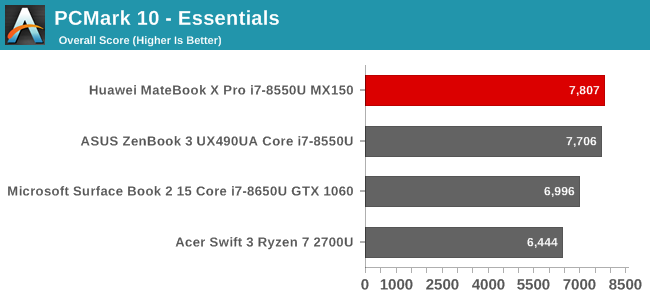
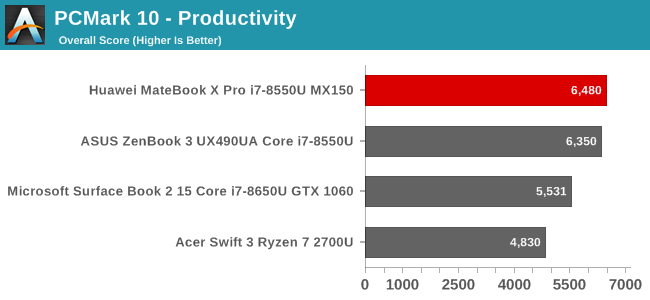
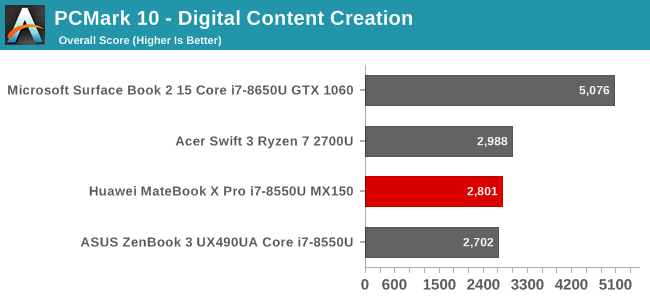

We’ve been testing the latest version of FutureMark’s PCMark suite for a while now, and are now switching over to it for all future reviews. If you’re not familiar with PCMark, it’s a full system test which factors in all aspects of a machine in a couple of different test suites. Essentials is “everday ways people us a PC” and includes web browsing, video conferencing, and app startup times. Productivity tests office applications such as word processing and spreadsheets. Digital Content Creation focuses on photo editing, video editing, rendering, and visualization. The suite then combines the sub-scores into an overall result.
The Huawei MateBook X Pro scores about mid-pack overall, but compared to the other devices in its class, it is right where expected.
Cinebench
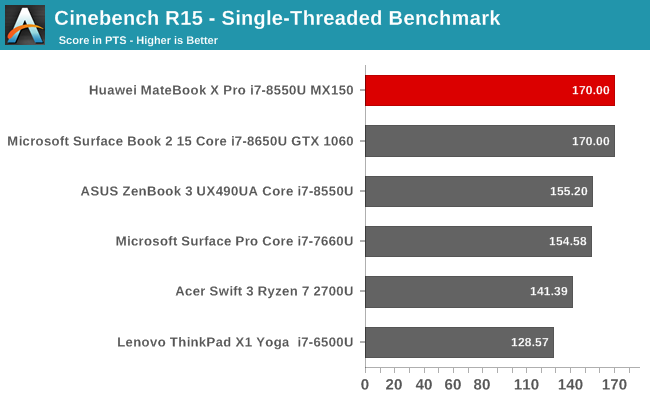
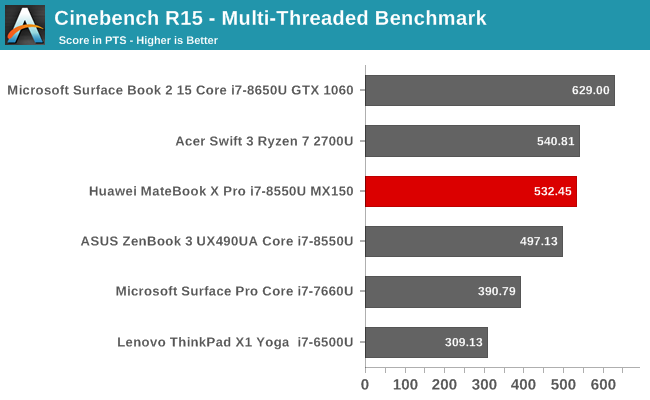
Cinebench lets us test just the CPU performance on rendering in both a single-threaded run, as well as a multi-threaded test. Once again the Kaby Lake Refresh does very well here, with great single-threaded performance, but the extra cores compared to last year’s dual-core CPUs provides a big boost for the threaded tests.
x264
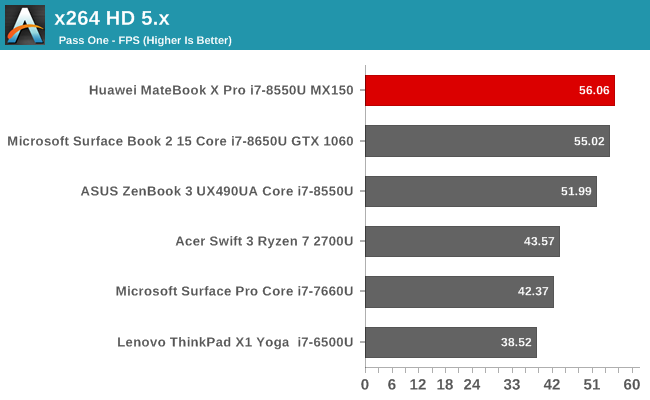

Another CPU test, x264 encodes a video in two passes using the CPU, and it likes lots of cores and lots of frequency. The Huawei performs very well here again. This test is quite a long test, and it runs four times sequentially, and the laptop got its best results on the third and fourth runs, so early indications are that the heat management works well on this device.
Web Tests
All of our web tests are run using Microsoft Edge as the default browser, and unlike our other tests, the browser is never a static thing. Each update generally improves performance of the JIT compiler, so over time, devices tend to get faster.
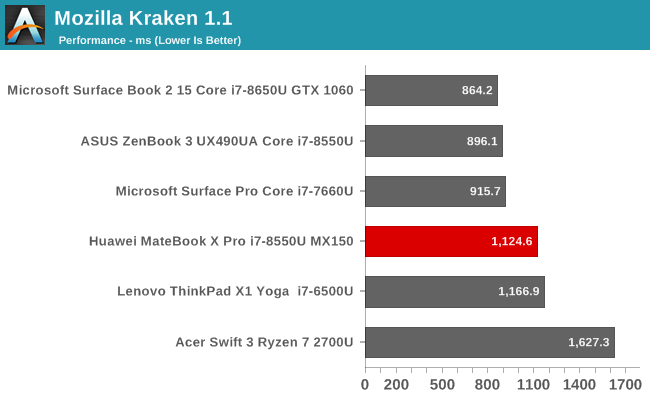
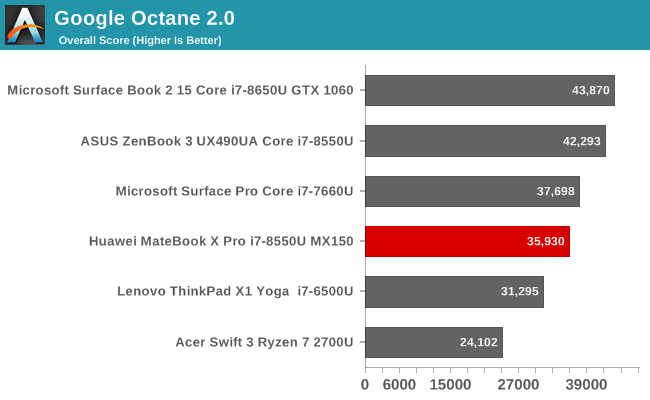
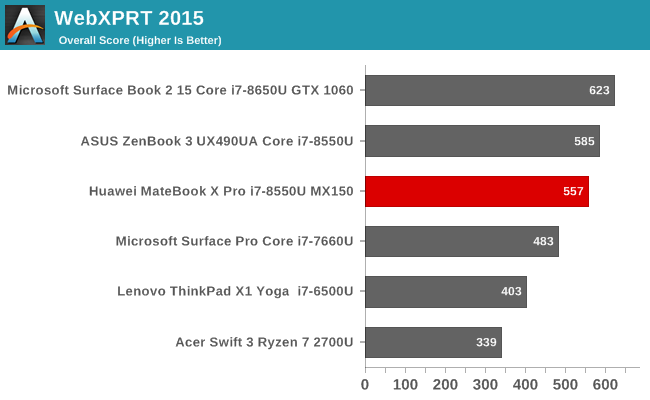
We’ll be changing our web testing soon, since all of these tests are now dated, so if there’s some web tests you’d like to see us include in the future, please let us know in the comments.
Storage Performance
Huawei uses M.2 NVMe PCIe SSDs in the MateBook X Pro lineup, as you’d expect, and the review unit shipped with an LITEON CA3 512 GB model. The drive is a TLC model, which isn’t unexpected in this price range, and is rated at 2900 MB/s read, and up to 1200 MB/s write, with 260K IOPS.
We were able to hit 3084 MB/s sequential read, and 2039.1 MB/s sequential write, with close to 300 MB/s read and write at 4 KB Q32, which is pretty good for a TLC drive. This is with a system that’s fully patched for Spectre and Meltdown as well.
Huawei is multi-sourcing drives though since SSDs are a commodity at this point, so there’s no guarantee what you’ll have in any unit. We’ve seen Toshiba, Samsung, and LITEON.


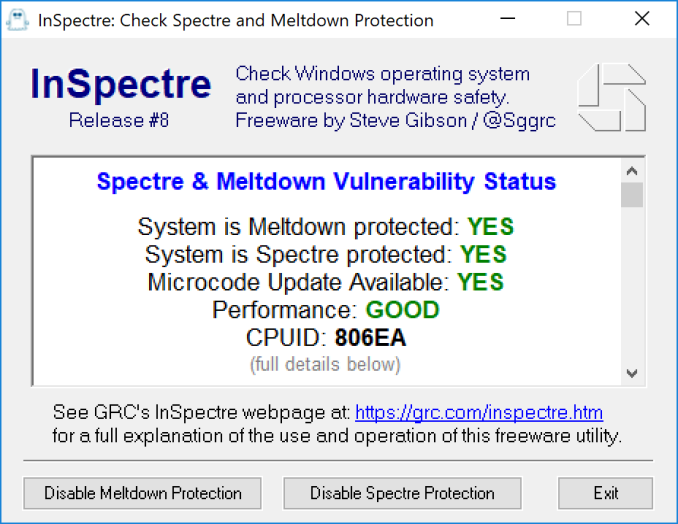








77 Comments
View All Comments
MrSpadge - Wednesday, June 27, 2018 - link
I really like the meaningful and fairly priced separation between the i5 and i7 model - keep it simple and the upgrade noticeable to the user.SirCanealot - Wednesday, June 27, 2018 - link
Actually, I was thinking the same thing! For the sake of $300 I can upgrade almost everything on the system. For $300 to do that, it's quite a 'may as well' situation! :)DiscoDJ - Wednesday, June 27, 2018 - link
I know the internet is international in scope, but I do find it interesting that this article doesn't even mention the security issues the U.S. Govt. (whatever you may think of it, right now) has with Huawei or ZTE. Is there an article on this site somewhere that dismisses these concerns as unfounded?RedKiwi - Wednesday, June 27, 2018 - link
Reading through the summary of the House intelligence report on Huawei and ZTE, it seems more of a "not worth the risk" type of situation. Investigating hardware provided by Huawei and ZTE was out of the scope of the investigation. The House only questioned their involvement with the Chinese government. Both companies were unable to provide a satisfactory answer to the committee. By not allowing Huawei and ZTE to sell telecommunications equipment to US carriers, it removes the possibility of snooping even if there is no risk in the first place.I do believe consumer hardware Huawei makes is safe for general use. It might not be worth it for the government to risk.
On a side note, I wish some of these decisions would be made in other parts of the US government such as environmental laws.
vanilla_gorilla - Wednesday, June 27, 2018 - link
That's one of the most reasonable replies to that question I've seen.But we can't ignore the fact that in 2017 ZTE plead guilty to illegaly exporting US technology to Iran and North Korea.
Let me say that again: Iran and North Korea. In violation of international trade sanctions.
Then when the US called them on it, they agreed to reprimand employees and pay a fine. Instead, they only fired 4 officials and provided bonuses to 35 others. That's why the US Department of Commercen banned companies from buy ZTE products.
I don't think there's much more anaysis the government needs to do. Security is all based on trust and ZTE has zero. I wouldn't trust them as far as I could throw them.
ianmills - Wednesday, June 27, 2018 - link
Well the results sound about par for how the US handled their own 2009 financial crisis hahainvinciblegod - Wednesday, June 27, 2018 - link
"But we can't ignore the fact that in 2017 ZTE plead guilty to illegaly exporting US technology to Iran and North Korea. Let me say that again: Iran and North Korea. In violation of international trade sanctions."You say that like it's a super surprising thing but you'll be surprised to learn that many companies actually make a cost benefit analysis and more often than would be expected choose to illegally export US parts to those countries. They just know that if they get caught they will pay a fine and then everything is fine. Just search "companies that violate sanctions to iran" on google and you will see how many companies do it and get caught. ZTE obviously miscalculated on how much they could get away with in the plea deal.
invinciblegod - Wednesday, June 27, 2018 - link
Also, ZTE is not Huawei.Samus - Thursday, June 28, 2018 - link
LOL I was about to say the same thing.Oxford Guy - Tuesday, July 3, 2018 - link
Yep. If the benefit (the profit) outweighs the slap on the wrist (the cost) then why wouldn't any corporation go for it? Corporations are not people. They're financial mechanisms designed to enrich some people. They just happen to have real people to do some of that work (along with AI, robotics, etc.).